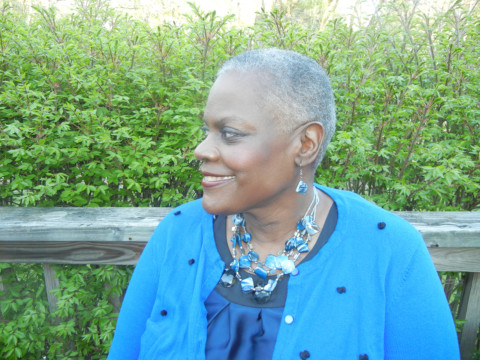
Cheron Wicker sank to her knees and began weeping, the contents of her purse and the bags of groceries she had dropped littering the floor of her suburban Maryland kitchen. As the searing pain in her index finger left her unable to reach the counter with the bags, Wicker felt an overwhelming sense of despair. Looking up, her gaze fell on a rack of kitchen knives. An idea that would have been unthinkable months earlier flickered through her mind.
That morning in the fall of 2012 when she briefly considered cutting off her finger was the lowest point in her seven-year ordeal, recalled Wicker, a former public affairs official at the US Maritime Administration. The Columbia resident had repeatedly consulted pain specialists and orthopaedic surgeons, as well as her internist and endocrinologist; all were mystified by the persistence of her constant, excruciating pain.
Wicker had even undergone two operations to replace the herniated disks in her neck that were believed to be the cause of the pain. She had taken all sorts of painkillers and become dependent on the sleeping pill Ambien to buy her a few hours of relief each night. She was increasingly convinced that she must be crazy; madness seemed to be the only reason that nothing had worked.
The real reason, she would learn weeks later when she saw a new doctor, was simple: The pain in her fingertip was caused by something inside it, not by a pinched nerve in her neck.
In December 2012, after a third surgery, her pain vanished.
“I had to convince her that I knew what I was doing,” recalled Baltimore orthopaedic surgeon Raymond Pensy, who diagnosed Wicker’s unusual disorder minutes after meeting her. “She was at her wit’s end.”
Wicker, now 57, first noticed the pain at the tip of her left index finger in the spring of 2005. “It felt like a paper cut,” she said. She carefully inspected the area several times, once using a jeweller’s loupe to magnify her view, but saw nothing. She tried her best to ignore the pain, which was fleeting. At the time she had bigger health concerns: She had recently been diagnosed with Type 2 diabetes and was learning to manage that.
Several months later, when the pain intensified, Wicker consulted her internist. She worried she might have developed neuropathy, nerve damage caused by diabetes. The internist reassured her that was not the case and sent her to a hand surgeon.
By the time she saw the hand surgeon in early 2006, the pain was relatively constant and Wicker was avoiding using the finger — a hardship when it came to typing and to enjoying her hobby of playing the drums. The specialist ordered an X-ray, an MRI scan and a nerve conduction test, which is used to evaluate problems in muscles or nerves. All were negative.
Wicker recalled that the hand surgeon briefly inspected her finger “and summarily dismissed it, saying, ‘There’s nothing here.’” She said she felt like “a wimp” — a painful fingertip sounded so trivial.
Several months later, Wicker consulted a second orthopaedist. He wasn’t sure what was wrong, and he prescribed a course of physical therapy. It did nothing for her finger, but after Wicker developed occasional numbness in her left shoulder, he recommended another six months of therapy. “Everything seemed to take three to six months,” Wicker said.
Because her fingertip pain was worsening, the orthopaedist also prescribed a variety of drugs including anti-inflammatories and increasingly strong painkillers, including oxycodone.
“None of it worked,” Wicker said. “The throbbing and burning was still there, but now I was high.”
During the next four years she interspersed visits to her internist and orthopaedist with a pain specialist. Their response was generally the same: We don’t see anything. One doctor suggested she might have carpal tunnel syndrome. Wicker spent hours online searching for answers, but came up empty.
In 2010, the orthopaedist, a spine surgeon, ordered an MRI of Wicker’s neck and upper back. Wicker remembers feeling “ecstatic” when she heard the result, which at long last sounded like an explanation. The scan showed two badly herniated disks. The doctor told her he thought these might be pinching a nerve in her neck, causing pain that radiated to her hand.
But Wicker remembers feeling perturbed by the doctor’s focus: He kept talking about her hand, which was fine, but not her fingertip, the site of now incessant burning pain. “I kept trying to redirect his attention” to the fingertip, she said, but he ignored her efforts and referred to her hand.
In April 2010, at the surgeon’s suggestion, Wicker underwent an operation to replace the spinal disks. The first thing she noticed when she awoke in the recovery room was the sharp pain in her fingertip.
Her orthopaedist counselled patience; improvement, he told her, could take weeks.
But instead of getting better, the pain worsened. By now, she was walking around with her left hand in a black sleeve used to treat carpal tunnel and her index finger wrapped, which made it feel somewhat better. She had discovered that if cool air touched the finger, the pain level shot up.
In November 2011, at the orthopaedist’s suggestion, she underwent a second surgery, this time on the disk just below the two that had been replaced earlier; the surgeon told her that an MRI showed that it too was herniated. “I fully trusted him, and the explanation made sense,” Wicker said.
But by the summer of 2012, the pain was “nearly unbearable.” The orthopaedist suggested she undergo a series of injections in her spine to dull the pain in her finger, which didn’t help. She tried acupuncture, which also failed.
In autumn, she made another appointment to see her internist. “I said, ‘I’m not leaving until you give me the name of an inpatient psychiatric hospital or a doctor who can figure out what is wrong with my finger.’”
The internist assured Wicker she wasn’t crazy and referred her to Pensy, a Baltimore hand surgeon.
Wicker remembers feeling deeply sceptical. She had already seen a hand surgeon, who told her he saw nothing. She called an acquaintance who had worked with Pensy; the woman spoke highly of him, and Wicker decided to make an appointment, not expecting much.
At the first visit in December 2012, Wicker recounted her history, including her fingertip’s sensitivity to cold temperatures. Pensy reviewed the results of a recent MRI of her finger, which showed nothing unusual — no evidence of a tumour or cyst, according to the report — and examined her finger.
Pensy noticed a very slight bluish discolouration underneath her nail, a recent occurrence. “The diagnosis to me is — I don’t want to say obvious — but as a hand surgeon it was,” he said, choosing his words carefully. “There just weren’t a lot of other things this could be.”
Pensy was virtually certain that Wicker had a glomus tumour, a rare, benign vascular growth that affects the hand, and often the fingertip. The cause is unknown and most glomus tumours occur in people between age 30 and 50. Like Wicker, many patients complain of temperature sensitivity and intense pain in one spot; some scientists speculate that the pain may be caused by nerve fibres that are present in glomus tumours. The bluish discolouration under her fingernail was the tumour itself. Smaller than the head of a pin; its size apparently eluded detection by the MRI.
Pensy said that the half-dozen doctors who saw Wicker before he did might have been led astray by two factors: the negative scans and the rarity of the problem. In his 19-year career, said Pensy, he has seen only two cases. A spine surgeon, he said, might not have been familiar with glomus tumours.
Pensy recommended that Wicker undergo surgery to remove the tumour, a procedure that would require taking off the nail. The operation should cure the problem which rarely recurs, he told her.
Wicker agreed, but tried to tamp down expectations that this operation would be any more successful than previous surgeries.
Pensy said that he remembers one unusual event. After Wicker was under anaesthesia, he pressed on the affected spot on her fingertip and she writhed in pain. “That was very abnormal,” he said, “and it gave me even more belief in what we were doing.”
Wicker remembers that when she awoke in the recovery room after the procedure, which took less than an hour, she braced herself for the familiar pain. Realising it was gone, she began crying.
“This time it was tears of joy,” she said. The pathology report confirmed Pensy’s diagnosis. When Wicker returned to see Pensy a few weeks later he remembers that he had barely entered the exam room when Wicker “jumped up and gave me a hug.”
Wicker said she is not sure what she could have done differently, but wishes she had seen Pensy before seven years elapsed. “I thought I was being really aggressive going to specialists,” she said. “I was going by what I was being told to do — and all these heavy hitters were telling me the problem was a pinched nerve.
“I wish I wasn’t so patient a person,” she said.
–Washington Post











